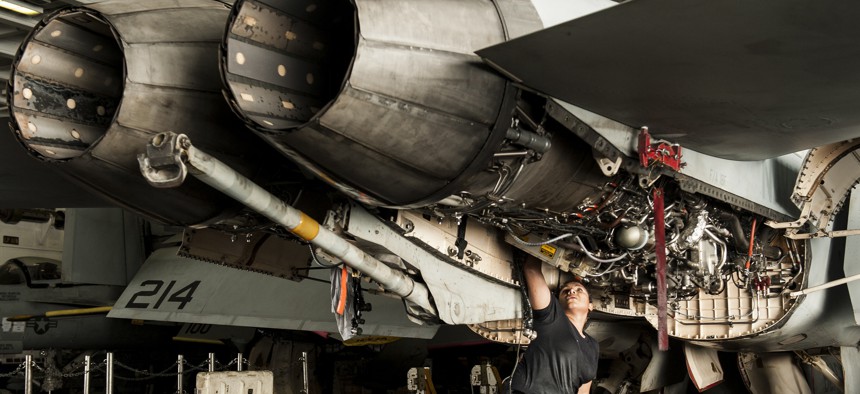
U.S. Navy Aviation Machinist's Mate 2nd Class Alexandra Mimbela performs maintenance on an F/A-18F Super Hornet aircraft assigned to Strike Fighter Squadron (VFA) 213 aboard the aircraft carrier USS George H.W. Bush (CVN 77) Aug. 21, 2014. Mass Communication Specialist 3rd Class Brian Stephens
Predicting When Weapons Will Break is a Hot New Market. Microsoft Wants In.
The company touts its commercial artificial intelligence as ripe for the military.
As the Pentagon shops for technology that can predict when its weapons might break, Microsoft (MSFT) is shopping its artificial intelligence to defense decision makers in Washington.
The firm’s touting its technology comes as companies large and small look to score deals in this emerging military market.
“Using a lot of [this machine learning technology] really is about lowering your total cost of ownership for a particular asset,” said Jim Ford, director of cloud strategy and solutions for Microsoft Federal, while showing off the technology on Tuesday at a pop-up exhibit in Washington just blocks from the White House.
The Redmond, Washington-based company — probably best known for its personal computer operating system — has been demonstrating its AI and machine-learning tech for military officials in recent weeks. The push comes as rival Google looks to distance itself from a different type of Pentagon artificial intelligence project — one that uses the algorithms to identify objects in drone video.
Senior military officials, especially in the Air Force, say they need need artificial intelligence-driven predictive maintenance technology. The tech is already is used by commercial airlines. And the Air Force is experimenting with predictive maintenance technology on its C-5 cargo planes and B-1 bombers — two aircraft historically in short supply due to frequently-needed repairs.
Microsoft and engine-maker Rolls-Royce built a platform that predicts when aircraft power plants will break down. The program also manages the necessary maintenance and logistics for parts supplies.
“Rolls-Royce did not go out and replace their entire infrastructure,” Ford said. “What they did is they understood what they could use with their existing infrastructure and … put a layer of smarts on top of it.”
Being able to modernize existing supply chains and collect data from military planes and ships — which in many cases are decades old — is key.
Even on older military aircraft, there are still instruments that already gather data that maintainers can collect after a flight.
“There’s ways of being able to collect the data,” Ford said.
If the part fails for an airline, it could result in a canceled flight, or worse, a crash. For the Pentagon, it could also mean the success or failure of a mission. Ford said the technology could help the Navy improve readiness levels of its F/A-18 fighter jets and ships.
The system Microsoft built for Rolls-Royce combines machine learning with its Dynamics 365 and Azure programs “to aggregate all of the sensors and where the data is coming from off the aircraft,” he said. (Microsoft programs can run tailored algorithms created by other firms.)
Related: Here’s How Google Pitched AI Tools to Special Operators Last Month
Related: For Sale: Artificial Intelligence That Teaches Itself
Related: The US Air Force Is Adding Algorithms to Predict When Planes Will Break
Each Rolls-Royce engine is “instrumented with thousands of sensors” that record data, Ford said. One engine on the tilt-rotor V-22 Osprey aircraft creates about one terabyte of data on an average flight.
“Rolls-Royce understood that was an asset,” Ford said. “That data was as much part of their solution as a physical piece of equipment.”
During a demonstration of the program, data generated from an engine appeared on a giant touchscreen. The data showed a plane engine was burning more fuel than usual.
“Now when you talk about the aggregation of data, a lot of times you’re using machine learning — whether it be in a supervised or an unsupervised fashion — in which it should be able to provide correlated analytic insights,” Ford said. “You don’t necessarily know the cause, but now you can start to piece together ... if there’s an issue without having to look at things from a serial perspective.”
The data showed an engine valve was mispositioned and temperature levels were not normal. The machine then predicted a part would fail before its scheduled maintenance, allowing the airline to change the part before it broke.




